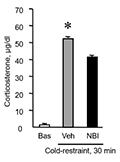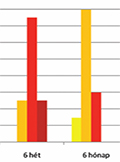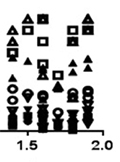The eLitMed.hu medical portal uses computer cookies for convenient operation. Detailed information can be found in the Cookie-policy.
Clinical Neuroscience - 2016;69(09-10)
Content
[Dissections of the supraaortic arteries]
[Dissection of the cervical and intracranial vasculature is a rare but important cause of ischaemic stroke especially in young adults. In the majority of cases it affects the extracranial vessels, mostly the internal carotid artery. It might be categorized as spontaneous or traumatic, causing diverse clinical symptoms. Dissection might lead to ipsilateral stroke mainly by artery-to-artery embolisation. Due to its relative rarity compared to the classic ischaemic stroke of the elderly, there are much less clinically relevant information for the clinician to rely on. Several large, randomised, multicentered, prospective studies and some smaller, retrospective analyses have been published recently concerning the genetic background, epidemiology, acute care and secondary prevention of supraaortic arterial dissection which helps the neurologist to provide evidence-based care for his patient. Our aim is to give a short, up-to-date overview of arterial dissections with two case reports.]
[Eating disorders and pregnancy - a review of literature]
[Eating disorders are psychosomatic disorders affecting primarily women, and influence reproductive functions as well. They have an impact on ovarial cyclem fertility, course of pregnancy, process of delivery, post partum period. Moreover, some data show that they can influence the adult health status. Extensive research from the last three decades call the attention to the fact that besides the classical eating disorders (anorexia nervosa and bulimia nervosa) the newer types (e.g., orthorexia nervosa), and subclinical disorders also occur in a subgroup of pregnant women. For this reason it is of key importance that the personnel working in the territory of obstetrics and gynecology have a solid knowledge about the symptoms, screening and therapeutical opportunities, and outcome of these disorders. The review summarizes the recent research data about the relationship of eating disorders and pregnancy.]
[Functional magnetic resonance imaging studies in pain research]
[Functional imaging studies opened a new way to understand the neural activity underlying pain perception and the pathomechanism of chronic pain syndromes. In the last twenty years several results of functional magnetic resonance imaging (fMRI) studies have been published about examining the different aspects of complex pain experience. The aim of these studies is to understand the functioning of the pain control system, the so-called pain matrix, activated by acute nociceptive stimulus. Another important field of pain research is the investigation of neuronal processes underlying chronic pain, since the pathomechanism of this is still unclear. Our review aims to provide insight into the methods of pain research using fMRI and the achievements of the last few years.]
Stress-induced corticosterone rise maintain gastric mucosal integrity in rats
Background - To investigate contribution of glucocorticoids to the maintenance of gastric mucosal integrity during stress we predominantly used ulcerogenic stress models. Using these models we demonstrated that glucocorticoids released in response to the ulcerogenic stimuli attenuated their harmful action on the gastric mucosa. Purpose - In the present study we hypothesized that mild stressors does not damage the gastric mucosa due to gastroprotective action of glucocorticoids released in response to these stressors. Methods - To verify the hypothesis the effects of normally non-ulcerogenic mild stimuli (15-30 min cold-restraint) on the gastric mucosal integrity have been studied under the circumstances of inhibition of the hypothalamic-pituitaryadrenocortical axis in rats. The hypothalamic-pituitary-adrenocortical axis was inhibited by: 1) fast inhibitory action of metyrapone, inhibitor glucocorticoid synthesis; 2) fast inhibitory action of NBI 27914, the selective antagonist of cortricotropin- releasing factor receptor type 1; 3) delayed inhibitory action of a single pharmacological dose of cortisol injected one week before the onset of stress stimulus. Results - Each of these pretreatments significantly decreased 15-30 min cold-restraint-produced corticosterone levels: 37.2±1 vs 22.5±1.2 (p<0.05) after metyrapone; 52.1±0.9 vs 41.4±1 (p<0.05) after NBI, and 64.2±4.2 vs 16.7±1.5 (p<0.05) after cortisol pretreatment. The inhibition of stress-induced corticosterone rise resulted in an ap - pearance of gastric lesions after the onset of these mild stressors in rats. Conclusions - The results suggest that in rats with inhibited stress-induced corticosterone rise normally non-ulcerogenic stimuli are transformed into ulcerogenic ones and confirm the hypothesis. The findings further support for the point of view that glucocorticoids released during acute stress are gastroprotective factors.
Frequency and types of headaches in patients with metabolic syndrome
Background - Metabolic Syndrome (MetS) and headaches are common public health problems in whole world. The relationship between headaches and the MetS isn’t understood clearly. Purpose - The aim of this study is to determine the prevalence and types of headaches, and evaluate the relationship between headache characteristics and clinical and laboratory parameters analyzed in patients diagnosed with MetS. Materials and methods - Of the patients diagnosed with MetS in Endocrinology outpatient clinics between July 2011 and July 2012, 202 patients were included in the study. Hemoglobin, fasting blood glucose (FBG), total cholesterol, triglyceride, HDL and LDL cholesterol, thyroid function tests and HbA1c values of all patients were recorded. Beck Depression Inventory (BDI) and Beck Anxiety Inventory (BAI) were applied to all patients. The headache severity was assessed by Visual Analog Scale (VAS). Results - The prevalence of headache in patients with MetS was found to be 61.4%. The incidence of headache was higher in female patients (F: 86.4%, M: 13.6%). The distribution of the subtypes of headaches was as follows: Episodic Tension-Type Headaches (ETTH) 24.8%, Episodic Migraine 14.4%, Chronic Tension-Type Headaches (CTTH) 11.3%, Episodic Tension-Type Headaches (ETTH) and Episodic Migraine 7.9%, and other types of headaches (Cervicogenic Headache and Cluster Headache) 3%. No statistically significant relationship was found between headache and non-headache groups in terms of body mass index, waist circumference, and the laboratory parameters (p>0.05). The mean BDI and BAI scores were higher in the headache group (p<0.001 and p<0.001). No significant difference was found between the mean MIDAS scores in the subtypes of headaches (p=0.35). In the headache group, there was a significant relationship only between triglyceride levels and attack frequency, duration and severity. Conclusion - Prevalence of headache in patients with MetS was 61.4%. The incidence of subtypes of headaches was similar to those in the general population. A relationship was found between triglyceride levels and attack frequency and severity. The result may be important to draw attention to the evaluation of triglyceride levels for reducing the frequency and severity of attacks in patients with headaches.
Adult attachment and parental bonding in irritable bowel syndrome and in panic disorder - Implications for psychotherapy
Background and purpose - Attachment theory provides an integrative perspective about the interplay between cognitive, affective, behavioral and interpersonal processes and is relevant for understanding irritable bowel syndrome (IBS) and panic disorder (PD). The aim of the present study was to examine the adult attachment style and parental bonding of IBS and PD patients. Methods - In a cross-sectional questionnaire-based study, 65 PD and 65 IBS patients with clinical diagnosis participated. Measures were Attachment Style Questionnaire, Experiences in Close Relationships Scale - Revised, and Parental Bonding Instrument. Results - The frequencies of insecure attachment (80.0% vs. 63.1%) and paternal neglect (35.4% vs. 16.9%) were higher in IBS than in PD (χ2 (1)=4.571, p=0.033, and χ2 (3)=7.831, p=0.050, respectively). The frequency of secure attachment was significantly higher for optimal paternal bonding than with suboptimal paternal bonding (75.0% vs. 21.9%, χ2 (1)=19.408, p<0.001). According to the results of multiple binary logistic analysis, optimal paternal bonding predicted secure attachment after adjusting for the background variables (OR=9.26, p=0.001). Conclusion - A high frequency of insecure attachment was present in both groups, especially in IBS. With regard to maternal bonding, IBS and PD groups showed similar patterns, while an apparent difference was observed for paternal bonding. These highlighted the developmental similarities of these two, symptomatically different disorders. While optimal maternal bonding did not predict adult attachment security, paternal bonding did thus replete with therapeutic implications. Attachment functions, like responsiveness, attunement and affection modulation were apparent in the psychotherapist-patient relationship as well.
[Our experience with the use of Active-C cervical prosthesis]
[Objective - The most widely used surgical procedure in the treatment of cervical spine disc hernias have been the anterior cervical discectomy and fusion for decades. The usage of cervical disc prostheses enabled us to preserve the movements of the affected segments, hereby reducing the overexertion of the adjacent vertebrae and discs. Our goal is to follow our patients operated with Active-C prosthesis (which is used in the Institute since 2010) to gather information about the change of their complaints and about the functioning and unwanted negative effects of the prostheses. Question - Is the usage of Active-C prosthesis an efficient procedure? Methods - Between 2010 and 2013, performing the survey of neurological conditions and functional X-ray examinations. We measured the complaints of the patients using the Visual Analogue Scale, Neck Disability Index and Cervical Spine Outcomes Questionnaire. The control group consisted of patients who were operated in one segment using the fusion technique. Results - In the study group according to the Neck Disability Index scale after 18 months, seven patients had no complaints, while twelve persons reported mild and the remaining six moderate complaints. In the control group, moderate complaints were present in four patients, while twelve patients reported mild complaints. The other eight persons showed no complaints. According to the results of the Visual Analogue Scale in the group of prosthesis, the degree of referred pain decreased from 8.6 to 1.84 one and a half years after the surgery. A decrease was observable in the case of axial pain too, from 6.6 down to 1.92 (p<0.01). In case of three from the twenty-five patients there was no sign of movement in the level of the prosthesis. Conclusions - According to the present short- and mediumterm studies, the usage of the cervical disc prosthesis can be considered as an efficient procedure, but at the same time the advantages can only be determined in the long run, therefore further following and studies are required.]
Cerebral vasomotor reactivity in fibromyalgia patients and its relationship to central neuropathic pain
Background - Cerebral vasomotor reactivity, defined as the cerebral vasculature response to hypoxia, is not wellunderstood in fibromyalgia (FM) patients. This study investigated the difference in the cerebrovascular reactivity (i.e., responsiveness to hypercapnia was evaluated by use of breath- holding index) to the breath-holding index (BHI) between patients with fibromyalgia and a group of normal controls. Methods - The study included 40 FM patients and 40 healthy subjects. Cerebrovascular reactivity was evaluated using the BHI, which is a nonaggressive, well-tolerated, real-time, reproducible screening method to study cerebral haemodynamics. Insonation depth and basal velocity were symmetrical and not significantly different between the two groups (p>0.05). All patients completed the Revised Fibromyalgia Impact Questionnaire (FIQR), Hospital Anxiety and Depression Scale (HADS), visual analogue scale (VAS), and the somatization subscale of the SCL-90-R symptom checklist. Results - The BHI ranged from 0.30 to 2.20 (mean 1.11±0.45) in the FM patients and 1.10 to 2.80 (mean 1.90±0.35) in the control group (p<0.001). Disease duration and right BHIaverage and left BHIaverage values exhibited a significant negative correlation (r=-0.877; p<0.001, r=-0.842; p<0.001, respectively). As pain and fatigue scores increased, the right BHIaverage and left BHIaverage values decreased (r=-0.431; p=0.005, r=-0.544; p<0.001, r=-0.341; p=0.031, r=-0.644; p<0.001, respectively). Conclusions - BHI values showed that cerebrovascular reactivity in FM patients decreased in comparison to healthy individuals. BHI decreased as disease duration and severity increased. Cerebrovascular reactivity decreased in FM patients, and this phenomenon should be accepted as an abnormality. Additionally, this outcome may have been the result of a mechanism responsible for central neuropathic pain.
[Operation - rehabilitation - employment]
[In this article we would like to bring the attention to the importance of early rehabilitation, coordinated operation of different subdivisions of rehabilitation and the expanding opportunities after medical care through following a 38- year-old female patient's case who was operated 6 years ago with anaplasticus oligodendroglioma. We find it important that the experts working on the field of health care, social services or labour should be aware of the possibilities of rehabilitation of their patients from the capability assessment, through its development until their placement in integrated labour market. It is important, that even during the medical care both the client and their relatives receive proper information.]
Restless Leg Syndrome/Willis-Ekbom disease in women with iron deficiency anemia
Background and purpose - Restless Leg Syndrome (RLS) also known as Willis-Ekbom Disease (WED) is a common condition associated with reduced quality of life and other medical conditions, particularly cardiovascular diseases. Despite its common occurrence, it is widely underdiagnosed and undertreated. Therefore, identification of high-risk individuals for RLS/WED bears diagnostic and therapeutic significance. Iron deficiency anemia has a role in the pathophysiology of RLS/WED and both conditions have been reported to occur higher in females. In this study, the frequency of RLS/WED among women diagnosed with iron deficiency anemia was examined as well as laboratory variables that could guide the clinician in the diagnosis of RLS/WED. Methods - A total of 51 women attending to the department of internal medicine with complaints of fatigue and tiredness and diagnosed as having iron deficiency anemia were evaluated using the International Restless Leg Syndrome Study Group (IRLSSG) diagnostic criteria for RLS. Laboratory variables were recorded. The severity of RLS/WED was assessed using the RLS rating scale in patients diagnosed with RLS/WED. Results - RLS/WED was diagnosed in 41.1% of the women with iron deficiency anemia. There were no significant differences between women with or without RLS /WED in terms of laboratory variables. Also, no correlations were observed between disease severity and laboratory variables. Conclusion - There is an 8 to 10-fold increase in the incidence of RLS/WED among women with iron deficiency anemia as compared to general population. Therefore, a possible diagnosis of RLS/WED should be kept in mind in all women with iron deficiency anemia.
1.
Clinical Neuroscience
[Headache registry in Szeged: Experiences regarding to migraine patients]2.
Clinical Neuroscience
[The new target population of stroke awareness campaign: Kindergarten students ]3.
Clinical Neuroscience
Is there any difference in mortality rates of atrial fibrillation detected before or after ischemic stroke?4.
Clinical Neuroscience
Factors influencing the level of stigma in Parkinson’s disease in western Turkey5.
Clinical Neuroscience
[The effects of demographic and clinical factors on the severity of poststroke aphasia]1.
2.
3.
4.
5.












